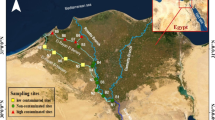Abstract
Benthic macroinvertebrate response to organic pollution generated by a trout farm, located in the upper Rio Tajuña (Central Spain), was evaluated by calculating Whittaker's and Camargo's dominance indices; Margalef s, Menhinick's, Camargo's, Shannon's and MacArthur's diversity indices; and several biotic indices, including the Trent Biotic Index (TBI), the Chandler Biotic Score (CBS), the Biological Monitoring Working Party (BMWP), the Average Score Per Taxon (ASPT) and the Overall Quality Rating (OQR). An upstream sampling site (S-1) and three downstream stations placed 10 (S-2), 150 (S-3) and 1000 (S-4) m below the fish farm outlet were selected along the study area. Site S-3 was situated just below a man-made waterfall (1.8 m in height). Winter, spring and summer macrobenthic surveys were conducted during 1986. Plecopterans, ephemeropterans, coleopterans, trichopterans, amphipods and planarians decreased in abundance or were basent at downstream sampling sites, whereas simuliids, leeches, chironomids and tubificid worms increased in abundance. All diversity and biotic indices had highest and lowest values at S-1 and S-2, respectively, and higher values at S-3 (below the waterfall) than at S-4. However, Shannon's and MacArthur's diversity indices and the TBI were less effective in quantifying differences among sampling sites, exhibiting the lowest positive coefficients of linear correlation with species richness and other diversity and biotic indices. Both dominance indices had highest values at S-2, but similar values at S-1, S-3 and S-4. Biotic indices (except the TBI) and Margalef s, Menhinick's and Camargo's diversity indices appear to be the most sensitive measures for assessing macroinvertebrate response to changes in environmental conditions downstream from the fish farm. In addition, temporal variation in species richness, Margalef s index and biotic indices was similar, exhibiting their highest coefficients of variation at S-4. It is concluded that small waterfalls may improve the streamns self-purification of organic pollution generated by trout farms.
Similar content being viewed by others
References
Alabaster, J. S.: 1982, EIFAC Technical Paper 41, 5.
Armitage, P. D., Moss, D., Wright, J. F., and Furse, M. T.: 1983, Water Res. 17, 333.
Balloch, D., Dames, C. E., and Jones, F. H.: 1976, Water Pollut. Control 75, 92.
Bergheim, A. and Selmer-Olsen, A. R.: 1978, Aquaculture 14, 267.
Beveridge, M. C. M.: 1984, FAO Fisheries Technical Paper 225, 1.
Butz. I. and Vens-Cappell, B.: 1982, EIFAC Technical Paper 41, 73.
Camargo, J. A.: 1989, Doctoral Dissertation, Madrid Autonomous University, Spain.
Camargo, J. A.: 1990, in Proceedings of the 1st International Symposium on Ecological Indicators, Florida (USA), Elsevier Applied Sciences Publishers (in press).
Camargo, J. A. and García de Jalón, D.: 1990, Regulated Rivers: Research & Management 5, 305.
Chandler, J. R.: 1970, Wat. Pollut. Control 69, 415.
Chutter, F. M.: 1972, Water Res. 6, 19.
Elston, R. C. and Johnson, W. D.: 1987, Essentials of Biostatistics, F. A. Davis Company.
Extence, C. A., Bates, A. J., Forbes, W. J., and Barham P. J.: 1987, Environmental Pollution 45, 221.
García de Jalón, D. and Gonzalez del Tánago, M.: 1986, Monografia No. 45, ICONA (Spain).
Hawkes, H. A.: 1975, in B. A. Whitton (ed.), River Ecology, Blackwell Scientific Publications, p. 313.
Hawkes, H. A.: 1979, in A. James and L. Evison (eds.), Biological Indicators of Water Quality, John Wiley and Sons, chap. 2.
Hellawell, J. M.: 1986, Biological Indicators of Freshwater Pollution and Environmental Management, Elsevier Applied Sciences Publishers.
Hilsenhoff, W. L.: 1977, Technical Bulletin No. 100, U.S. Departement of Nature Research.
Hinshaw, R. N.: 1973, Pollution as a Result of Fish Cultural Activities. Ecological Research Series, U.S. Environmental Protection Agency, Washington D.C.
Hughes, B. D.: 1978, Water Res. 12, 359.
Iilies, J. and Botosaneanu, L.: 1936, Verh. Int. Verein. Limnol. 12, 1.
Lenat, D. R., Smock, L. A., and Penrose, D. L.: 1980, in D. L. Worf (ed.), Biological Monitoring for Environmental Effects, Lexington Books, p. 97.
Liao, P. B.: 1970, Water Sewage Works 117, 291.
MacArthur, R. H.; 1972, Geographical Ecology. Patterns in the Distribution of Species, Harper and Row, Publishers.
Magurran, A. E.: 1988, Ecological Diversity and Its Measurement, Princeton University Press.
Mantle, G. J.; 1982, EIFAC Technical Paper 41, 103.
Margalef, R.: 1958, Gen. Syste. 3, 36.
Markmann, P. N.: 1982, EIFAC Technical Paper 41, 99.
Menhinick, E. P.: 1964, Ecology 45, 859.
Muñoz, M. J.: 1989, Doctoral Dissertation No. 77, INIA (Spain).
National Water Council: 1981, River Quality: The 1980 Survey and Future Outlook, National Water Council (London).
Pinder, L. C. V., Ladle, M., Gledhill, T., Bass, J. A. B., and Matthews, A. M.: 1987, Arch. Hydrobiol. 109, 207.
Shannon, C. E.: 1948, Bell System Tech. J. 27, 379.
Simpson, E. H.: 1949, Nature 163, 688.
Solbé, J. F.: 1982, EIFAC Technical Paper 41, 29.
Solberg, S. O. and Bregnballe, F.: 1982, EIFAC Technical Paper 41, 65.
Szluha, A. T.: 1974, Trans. Amer. Fish. Soc. 103, 226.
U. S. E. P. A.: 1972, Community Structure and Diversity Indices, U.S. Environmental Protection Agency.
Vannote, R. L., Minshall, G. W., Cummins, K. W., Sedell, J. R., and Cushing, C. E.: 1980, Can. J. Fish. Aquat. Sci. 37, 130.
Washington, H. G.: 1984, Water Res. 18, 653.
Whittaker, R. H.: 1965, Science 147, 250.
Wiener, N.: 1948, Cybernetics, or Control and Communication in the Animal and the Machine, Hermann et Cie., The MIT Press and Wiley.
Woodiwiss, F. S.; 1964, Chemy. Indust. 11, 443.
Author information
Authors and Affiliations
Rights and permissions
About this article
Cite this article
Camargo, J.A. Temporal and spatial variations in dominance, diversity and biotic indices along a limestone stream receiving a trout farm effluent. Water Air Soil Pollut 63, 343–359 (1992). https://doi.org/10.1007/BF00475501
Received:
Revised:
Issue Date:
DOI: https://doi.org/10.1007/BF00475501




